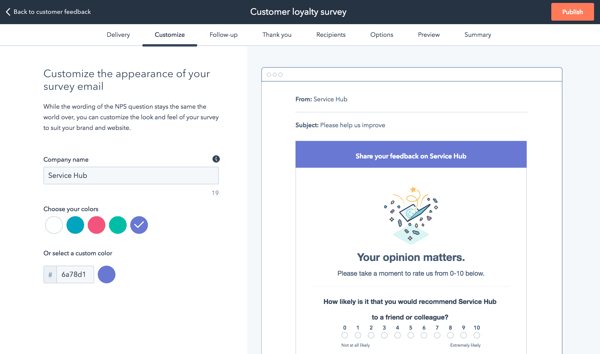Collecting — and acting upon — client feedback is an important way to enhance your company's reputation, whether it resides in the B2B or B2C industry. For example, 53% of shoppers believe that their feedback doesn't go to anyone who can actually act on it. In contrast, 77% of consumers view brands more favorably if they're known for seeking out and applying customer feedback.
How can you effectively collect feedback from your customers? Let's discuss 5 techniques in particular that you can use to get a pulse on how your clients are thinking and feeling.

1. Surveys
Who doesn't love a good survey? In all seriousness, sending out customer surveys is one of the easiest and most effective ways to get at least some basic feedback from your users.
Surveys are often sent after customer interactions, with companies opting for simple and quick surveys to minimize customer effort. The widely recognized customer satisfaction survey (CSAT) asks about satisfaction levels on a scale of 1 to 7.
Another popular survey type is the net promoter score (NPS) survey, in which customers are asked: "On a scale of 1 to 10, how likely are you to recommend our product/service to others?"
Regardless of whether you choose the CSAT survey, the NPS, or both, the main goal is to gather enough customer feedback to identify key trends that impact the overall buyer experience, both positively and negatively.
2. Feedback boxes
What if you want to empower your clients to provide open-ended feedback? Or what if you want to capture feedback concerning relatively minor (but still annoying) issues on your site? In both cases, using a feedback box may be the right way to go.
A feedback box is a simple input field at the bottom of each page on your site where users can quickly point out flaws in your website, product, or service. It provides a convenient way for customers to provide feedback without reaching out directly to your team.
Feedback boxes are a useful and unobtrusive method of capturing feedback that may otherwise go unnoticed.
3. Direct outreach
Of course, the most straightforward way to get client feedback is to directly ask them for it. You can have all the quantitative data in the world, but only by engaging with customers in detailed conversations will you be able to add important context to that data.
Conducting effective "exploratory customer interviews" requires skill. Keep the conversation focused yet open-ended. Ask about what clients want to see changed, why they feel the way they do, and how they would personally change your product or service if given the chance.
When asking about the customer's user experience, aim for detail. Ask clarifying questions if needed and take detailed notes, even considering recording the session for analysis.
By reaching out to your customers directly in this way, you'll gain access to a veritable treasure trove of qualitative data.
4. Social media
Social media offers a variety of ways to collect feedback from your customers. For example, "social listening" can help you to compile candid comments and opinions from a diverse group of users — opinions that you wouldn't necessarily learn about through the other channels discussed above.
You can also proactively leverage social media to collect customer feedback. One way to do this is by running a social media contest, in which participants must submit a review of one of your products or services. Another option would be an open poll asking users to pick which of your products they'd be most likely to recommend to a friend.
B2C companies may have more maneuverability in using social media for customer feedback, but B2B organizations can also explore ways to get their clients talking on social media platforms and mine those comments for actionable insights.
5. Site analytics
Finally, you may not have to interact with your customers at all in order to receive valuable feedback from them. How can that be possible? On the premise that "actions speak louder than words," you can always use analytics to measure your website's performance across a variety of pages, and see where your company is hot... and where it's not.
Metrics like bounce rate, number of visitors, session length, and popular links can provide valuable feedback on your website's performance and areas for improvement. Understanding how clients and prospects interact with your pages is essential for gaining important insights.

Reach Out to The Gist for Tailored Solutions
The techniques discussed can help collect vital feedback from customers, improve the business, and attract more customers. The team at The Gist can assist in implementing feedback systems directly in HubSpot to gain the necessary insights. Reach out today to start the conversation.